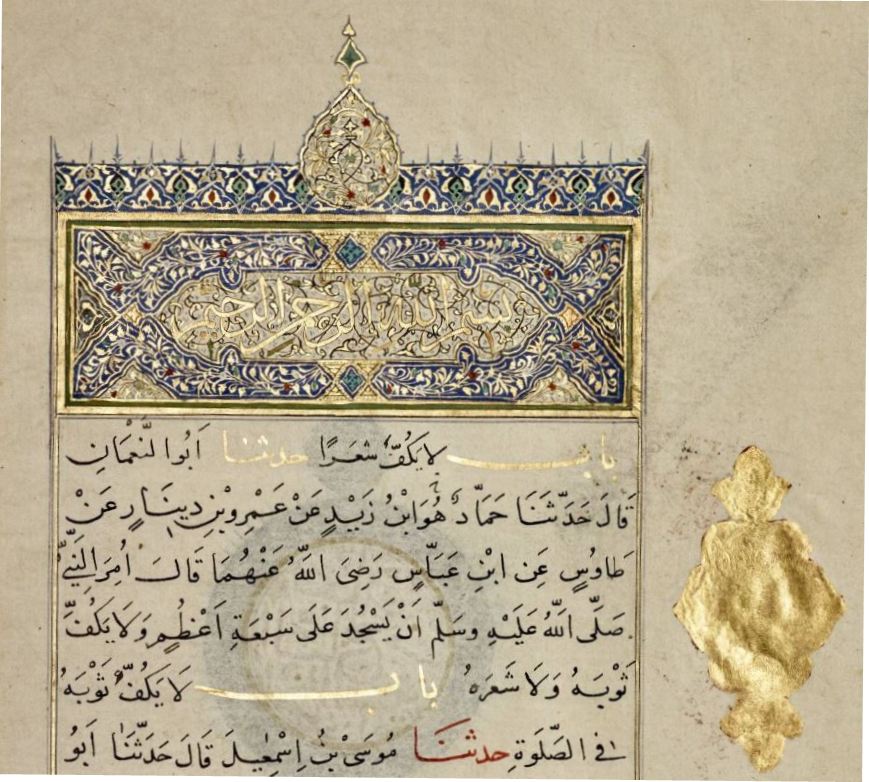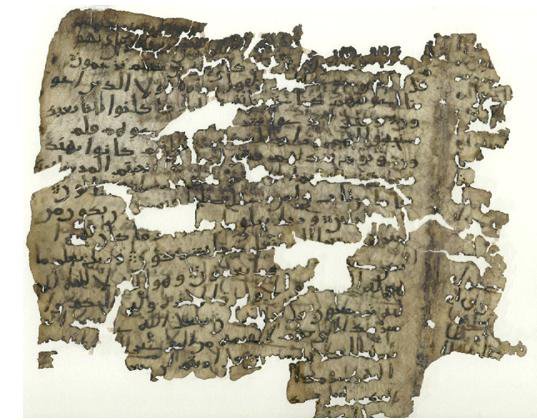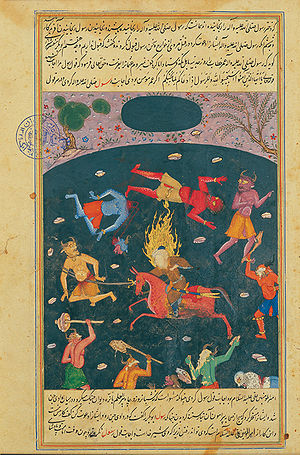
Scholars, preachers and Islamists have spread and handed down over the centuries hadith that are false and fabricated, and this is the reason for the travails of contemporary Islamic thought and its crisis with reality, the nation and the Arab Islamic mentality internally, along with its relationship with the outside world.
HADITH BEGAN to be fabricated during the lifetime of the Prophet himself and men became famous for their expertise in fabricating and falsifying prophetic hadith. It is for this reason that the Prophet ascended the pulpit on many occasions to warn against this with the words:
Lies against me have increased, and for him who lies deliberately against me a place is being prepared in Hellfire.
The word kadhdhāb (‘liar’) is an intensive form of the noun, and denotes one who is experienced in multiplying and forging lies. During his lifetime the Prophet spoke out against the profuseness of lying to the point that this phenomenon became widespread, whereby all and sundry were saying “the Prophet said this”. The Prophet himself heard these falsehoods of theirs and this is why he warned all Muslims to beware of them in the above mutawātir[1] hadith. And this despite the scarcity and rarity of mutawātir hadith concerning the level of a hadith’s validity. ‘Alī ibn Abī Tālib testified as to the soundness of the above hadith during the time of his caliphate when he was asked about the contradictions in what he heard concerning the Prophet, as is detailed in the work Nahj al-Balāgha.
Noticeable here is the long delay that intervened prior to the writing down of the hadith – which took place neither during the time of the Prophet nor that of his Companions nor the Tābiʽīn – but in some cases as late as the time of ‘Umar ibn ‘Abd al-ʽAzīz. The writing down of hadith was prohibited firstly to protect the ongoing collection of the Qur’ān, which was considered a priority, but also to prevent hadiths being mixed in with the Text. Abū Saʽīd al-Khudarī recalled the Prophet saying:
Do not write about me, whatever anyone writes about me other than the Qur’ān is to be erased.
Similarly the first caliph lamented that:
You speak hadiths concerning the Messenger of God that are divergent one from the other, and people after you will differ even more.
The second caliph also stated: “Let anyone who has any hadith erase it,” in the knowledge that those who could write these things down properly were very few in number. These people attempted to write down the Qur’ān, collecting it from scraps, bones, stones, palm leaves and animal skins, in addition to views from hadith that found themselves incorporated. In such fashion were the views of followers of Jābir and Zayd incorporated into the prophetic hadith, alongside the phenomenon of storytellers whose work found its way into commentaries and hadith.
The number of prophetic Hadith would take up more space than his entire lifespan
What is amazing is the huge number of prophetic hadith that have come down to us. They are so many that if you were to spread these out over the lifetime of the Prophet they would take up more space than his entire lifespan, even if he had spent every morning and evening doing nothing else but talk, converse and speak about related hadith. Not to mention their being oblivious to the basic themes in the Prophet’s life, discourse and activities, such as his Friday sermons which he delivered over a period of 10 years in Medina. Now even though the Medinans were the most enthusiastic supporters of the Prophet and his call, and the most assiduous in implementing his rulings, the Islamic heritage – for all its diverse sects and denominations – has not preserved for us anything of these Friday sermons of the Prophet. Yet these must have been more than 500 in number and were attended by the entire community of Muslims on any single Friday, when the Prophet himself led the prayer.
They also referenced the most crucial, sensitive issues of the day affecting their lives, issues of political and social import in addition to legal matters. Keep in mind the fact that the sermons were not drawn out as they are today but often lasted no longer than 10 minutes, and also the ability of the Arabs to memorise them, as they did the Muʽallaqāt odes.
Why does our history and the heritage not record any of this? Indeed, tradition records for us the Farewell Sermon, perhaps because it is another example of an important issue since it contained valedictory instructions given to the collected audience of all of the Muslims following the final pilgrimage. On the other hand the tradition hands down to us plenty of verbose tales of minor importance, such as that of a Bedouin who came from afar to ask the Prophet about a specific issue of no great import and one which was witnessed by no more than a single Companion. Yet these fill up many books of hadith and were handed down with many supporting chains of transmission and with an inordinate amount of importance attached to them.
Entire volumes were written on forgers and weak narrators
Most of the hadith associated with the Prophet are therefore of dubious authenticity, while the mutawātir examples are very few in number. This is why entire volumes were written on forgers and weak narrators such as Al-Bukhārī’s Al-Duʽafā’, al-Nisā’ī’s Al-Diʽāf, Ibn Hayyān’s Al-Diʽāf wal-Matrūkīn, Ibn al-Jawzī’s Al-Duʽafā’, al-Dhahabī’s Mayzān al-Iʽtidāl, Ibn Hajar’s Lisān al-Maydān, al-Halabī’s Al-Kashf al-Hathīth, al-Azdī’s Al-Duʽafā’, al-Husaynī’s Al-Mawdūʽāt and many others still, which we need to study more widely, deeply and comprehensively both for the great number and the considerable influence these hadith have wielded.
There are many hadith narrated on the superiority of certain people, or of foodstuffs or countries, animals, plants, insects, mountains and inanimate objects, or even on the condemnation of these and other things. The Shīʽite authority Muhsin al-Hakīm al-Tabātabā’ī even wrote down for us in his Mustamsik the undesirability of having dealings with other peoples, on the basis of some reports that claim that these people are descended from the Jinn, so that one should not have dealings with them nor marry them. The evidence for this comes from the narrations contained al-Kulaynī’s Kāfī, al-Saddūq’s Faqīh, al-Tūsī’s Tahdhīb, al-Majlisī’s Bihār, al-Jawāhirī’s Hadā’iq, al-Ardabīlī’s Jāmiʽ, or al-Khūnsārī’s Madārik, all of them consisting of hadith that are fabricated but which nurture negative attitudes towards others by advocating avoiding interaction with them or intermarrying with them. All this on the spurious grounds that their origins are from the Jinn, even though we are all sons of Adam and Eve. This is a form of racism that exists among certain groups of Muslims in our society.
Preachers and sermonizers have attained to a position of dominance in our time and the hisba[2] they promulgate is a historical phenomenon of fabrication. On being challenged, one hadith forger, Maysara ibn ‘Abd Rabbih opined: “I invented this as a hisba in order to get close to Almighty God!” This same also applies with things these people seek to attain, whereby some admit that:
“when we approve something we turn it into a hadith”… “We lie for the Prophet not against him” … “When we saw people engrossed in the fiqh of Abū Hanīfa and the Maghāzī of al-Wāqidī, we invented some hadith out of hisba to God Almighty.”
Such are the words of Nūh ibn Abī Maryam. Today we have preachers of lies and quackery such as Kamāl al-Haydarī, al-Muhājir, al-Karbalā’ī, al-Fālī, Yāsir al-Habīb, who relate overblown hadith on the Imams, on extremism, on declaring others ‘infidel’ and on proscribing their blood, wealth and honour.
Fabrication became a means of acquiring wealth, status and fame and fortune as they fabricated strange hadith unheard of by anyone else, in order to extract money from them.
Jaʽfar al-Tayālisī related the following account:
Ahmad ibn Hanbal and Yahyā ibn Muʽīn used to pray in the Al-Rusāfa mosque. One day a storyteller came and said that Ahmad ibn Hanbal and Yahyā ibn Muʽīn had said, on the authority of ʽAbd al-Razzāq, Muʽammar, Qatāda and Anas, that the Prophet had said: “Whenever anyone says ‘there is no God but Allah’, God creates from just one of these words a bird with golden claws and feathers of coral” [the story then goes on for about 20 pages]. Then Ahmad and Yahyā looked at each other saying: “this is the first time we’ve heard of this!” But they both kept their silence until he had finished his tale, had taken some money and sat down expectantly. Yahyā then beckoned to him so that he got up pondering his imminent reward. Whereupon Yahyā asked: “Who related this hadith to you?”- “Ahmad and Ibn Muʽīn!” – “But I am Yahyā and this is Ahmad! We have never heard of this. If you have to lie, then lie about somebody else”. And the man replied: “Are you Yahyā ibn Muʽīn?” – “Yes” – “Well, I always heard that Yahyā ibn Muʽīn was a fool! But it’s only now that I know this for a fact! I mean, as if you were the only Yahyā ibn Muʽīn and Ahmad ibn Hanbal in the world! I have written of 17 Ahmad ibn Hanbals and Yahyā ibn Muʽīns!” Whereupon Ahmad punched him in the face and said: “Let him get up.” And he got to his feet with an expression of mockery on his face.
Another motive was the desire to gain access to rulers and sultans by pandering to their passions, as in the case of Ghiyāth ibn Ibrāhīm al-Nakhaʽī who fabricated a hadith on the merits of playing with pigeons! He gained an audience with al-Mahdī, who enjoyed racing with pigeons, and was bid address the Commander of the Faithful, whereupon he recited the hadith: ‘The only contests allowed are those with arrowheads, horse-hooves and camel-hooves[3] [and by way of extending it here] and wings!’ Al-Mahdī ordered that he be rewarded, but as he departed went on to say: “I testify that your back is the back of a liar!” When al-Nakhaʽī left al-Mahdī had the pigeon put down.

Suggested Reading
Islamic sects played a major role in the fabrication of hadith that supported their denominations and undermined those of others, as explained by Ahmad Amīn, Taha Husayn, Hāshim Maʽrūf, al-Baghdādī, al-Shahrastānī and al-Nowbakhtī. In similar fashion the Ismāʽīlīs made use of every place in the Qur’ān that featured the number seven, and the Twelver Shīʽas everywhere where the number 12 occurred, so as to provide interpretations in their doctrine to hadith that had been fabricated by forgers. Al-Mughīra ibn Saʽīd stated how he had “invented 12,000 hadith on Jaʽfar al-Sādiq”, while al-Kashī records Jaʽfar al-Sādiq as saying that “al-Mughīra fabricated disbelief, atheism and exaggeration amongst us”. In fact, al-Sadiq was
surrounded by deviant forgers, such as al-Mughīra ibn Saʽīd, Abū al-Khitāb and al-Mufaddal ibn ‘Umar and others who attributed hadith to him, saying that the wisdom of the Imam was such that he had no need of praying or fasting … while a group of Shīʽa Muslims fabricated hadith lauding the merits of the Imams and diminishing the status of the caliphs, and attributed these to the Imams.
Many cultures and ideologies trace their foundation to these forged hadith
Hāshim Maʽrūf states that al-Husaynī was one of the Shīʽa who was critical of the Al-Kāfī collection, while others (the Akhbārīyyīn in particular) consider it to be entirely sound on the basis of the hadith associated with the Awaited Mahdī that runs: “The Al-Kāfī is sufficient unto our Party”. It is the most important source of Shīʽa hadith in spite of its inclusion of accounts on the distortion of the Qur’ānic text or of exaggeration concerning the Imams, and their hostility to others, and matters unacceptable to the intellect, to reality and to logic. The total number of the hadith in the work amounts to 16,199, very few of them hadith of the Prophet and most of them from the Imams, particularly al-Bāqir and al-Sādiq. Similarly, few of them may be considered ‘sound’ according to the opinion of the author of Lu’lu’at al-Bahrayn, or of al-Tahrāni in his Dharīʽa, or al-Tarīhī in his collected essays and his Bahr al-ʽUlūm fī Rijāl, al-Sabhānī in his Kulliyyāt or al-Tankabanī in his Qisas. About ʽAlī al-Ridā’ it is said that:
Bayyān lied about al-Sijād, al-Mughīra lied about al-Bāqir and al-Sādiq, Muhammad ibn Furāt lied about al-Kāzim and Abū al-Khitāb lied about al-Sādiq.
Al-Mughīra has many followers since he employed sorcery and magic, and played on the simplicity and the emotions of the people of the time. Such forgery was not without its effects on society, the economy and politics.
Many cultures and ideologies existing today trace their influence and their foundation to these forged hadith which subsequently became, bit by bit, turned into ready-made, canned templates for interpreting and understanding a decadent culture. This large quantity of fabricated hadith dominating contemporary Islamic thought and discourse is one of the causes of the Islamist intellectual crisis, the results of which impact upon our current reality and all its travails.
[1] See Glossary Hadith.
[2] See Glossary.
[3] An actual sahīh hadith narrated by Abū Dā’ūd, the contests mentioned being justified on account of their usefulness to training for jihad. (Ed.)
Main picture: The ḥadīth as scripture: a muṣḥaf-like page from the Ṣaḥīḥ al-Bukhārī with gold illumination. The passages calligraphically inscribed are Ḥadīths 815 and 816 from chapter كتاب الأذان : “The Prophet was ordered to prostrate on seven bony parts and not to tuck up his clothes or hair” (when performing ṣalāh). Unknown artist, Shiraz, dated 1400-1450. From the Keir Collection of Islamic Art, Object number K.1.2014.800.1.


